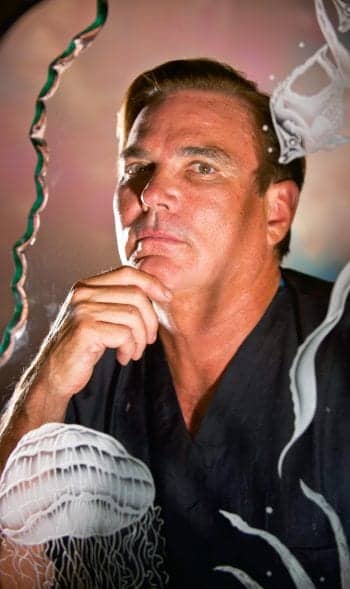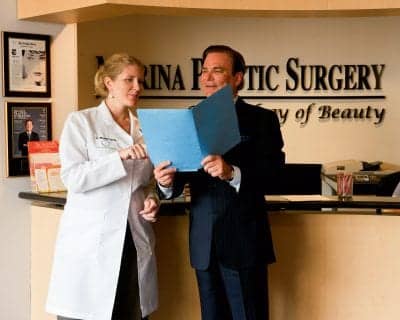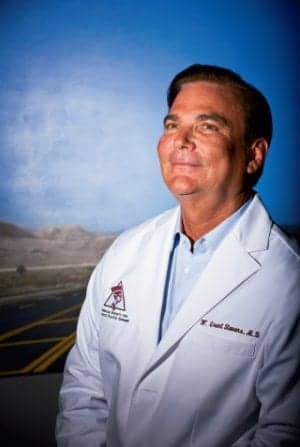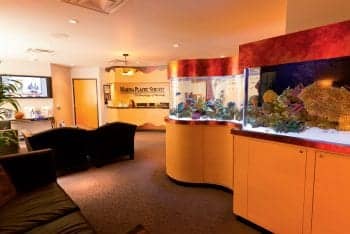Photos by Michael Justice

Grant Stevens, MD, FACS, stops in midsentence to calculate the length of time he has worked in aesthetic medicine. After what he thinks is more than 2 decades in practice as a board-certified plastic surgeon and medical director of Marina Plastic Surgery in the Los Angeles area, Stevens stops calculating and quips, “Certainly, it’s given me a chance to ponder the past. The first question is where did 25 years go? I still feel like a kid.”
As a member on the board of directors of the American Society of Aesthetic Plastic Surgeons (ASAPS), he functions as the chairman of media relations and is one of the society’s appointed traveling professors. He gets around, too—as a member of the American Society of Plastic Surgeons (ASPS) and a member of the International Society of Aesthetic Plastic Surgery (ISAPS).
In the Los Angeles area, Stevens is an active member at Marina del Rey Hospital, where he is a past chairman of the Department of Surgery. He is on staff at St John’s Medical Center in Santa Monica, Calif, and the Marina Outpatient Surgery Center. He is an associate clinical professor at USC, where he has recently taken on the role of co-director of the Aesthetic Surgery Division.
Stevens has persisted in being a leading voice for aesthetic medicine, not only as a mentor to other surgeons but their teacher. He stands in front of a long list of accomplishments, most notably the cohesive breast implant (aka, gummy bear breast implants), the Mentor CPG and the Sientra highly cohesive breast implants, the Mommy Makeover, the Laser Bra, and simultaneous mastopexy augmentation.
WATCHING EVOLUTION
Stevens holds as a priority the open discussion of what is in store for the future plastic surgeon. He actively promotes the viability and continuation of cosmetic plastic surgery by plastic surgeons.
“Turns out that 72% of board-certified plastic surgeons make the majority of their income from doing cosmetic plastic surgery,” Stevens notes. “Now, there’s a disconnect here. If 72% of the surgeons are making more than half their income from cosmetic surgery, then why aren’t we teaching cosmetic surgery?”
Stevens believes there is a legacy being created by his specialty, and he takes it personally. “I want plastic surgeons to remain significant in this space,” he says, “and the only way that we’re going to do it is by teaching the residents, even if they don’t do it for a lifetime. I’m not doing craniofacial surgery, but I had to do craniofacial training. I’m not doing neuro surgery but I did neuro training. And I respect the surgeons in the other divisions.
What about the practitioners against doing cosmetic surgery? “They have this sort of distrust for it or contempt for it—or jealousy, in my opinion, for it. There’s turf war issues even within plastic surgery.” Stevens adds. “Now, outside the division, we’re trying to embrace the core.”
THE CORE
Stevens is quick to says it is “ophthalmic plastics, facial plastics, derm-surg, and then aesthetic plastics, and we’ve come together formally and met and had core meetings,” he says. “There is still a fair amount of teeth gnashing and discontent, but at least we’re talking. I’m in favor of the core. I know that certain political people are not.”
He believes that, as a group, plastic surgeons need “to turn our eyes on the noncore—the dentists doing Botox, breast surgery, and liposuction; the general practitioners doing laser surgery. There are a lot of very undertrained people in this space doing things that they really have no business doing. Ultimately, the Hippocratic Oath is first we do no harm. It seems part of that is first we have training, knowledge, and experience. If the training is coming from equally unqualified people, that’s not training. I can hit a million golf balls and I’m not Tiger Woods, just because I hit a million golf balls. Well, I’ve hit all million poorly. When you listen to some of these nontrained, noncore people, they’ll say, ‘Well, I’ve done it this many times, or I’ve learned it from this guy who’s done it this many times.'”I don’t think the number of times you do it is the sole criteria. I think it’s the quality in which you do it. We owe it to the patient, to the consumer, to provide the best service of everything. To have people dabble in it, jump in and say [that] because they went to a weekend course at a hotel, [and say] I’m now a cosmetic surgeon. It’s wrong. You walk into your dentist; they’re selling you Botox. That’s crazy to me.”

Michelle Spring, MD, one of the associates at Marina Plastic Surgery, reviews a chart with Stevens in the Marina del Rey, Calif-based office.
This is a positive step toward keeping the plastic surgery within plastic surgery, then? Yes, he says, but, “The ultimate goal really is to educate. We’re educating residents to be better plastic surgeons. I want them to see what we offer and also hopefully stimulate interest in that division” of plastics. To just be better, well-trained, well-rounded plastic surgeons. Even if they say they’re not going to do cosmetic surgery when they’re training, when they’re idealistic, the statistics are they will make a significant income from cosmetic procedures,” if the past is any indication, he adds.
The majority of them will generate more than half of their income from cosmetic surgery procedures, Stevens remarks, “even though they’re wonderful hand surgeons, or microsurgeons, or craniofacial surgeons, or pediatric surgeons, or reconstructive surgeons. These are all divisions we get tested on. There is a commitment to test, in terms of the boards, to test for cosmetic plastic surgery knowledge base both written and oral, or practical, and so with that commitment by the American Board of Plastic Surgery will come better training around the country.”
He is encouraged and enthusiastic because he is seeing so many physicians who hold a commitment to train their residents. “It’s an economic commitment, a time commitment, a physical space commitment,” he says. “There will be some that go slower than others. Change happens with pain, and it’s a little slow at first and then it will pick up, it will accelerate, and then it will happen. We still haven’t gotten to 50% yet. It’s still at the beginning. It’s terribly exciting.”
SPECIALISTS UNITE
As Stevens looks into the future of his field, he sees integration. “I see specialization and subspecialization within cosmetic plastic surgery. The two biggest changes I see are integration of the various subspecialties of cosmetic plastic surgery. Under one roof, facial plastics, derm-plastics, ocular plastics, aesthetic plastics, and traditional board-certified plastic surgeons.”
The people that embrace this rethinking of aesthetic medicine to accommodate the noncore practitioner under one roof—for example, cosmetic dentistry and OB/GYN—will excel, Stevens says.
Looking at the growth of all nonsurgical cosmetic procedures—nonsurgical body contouring and facial rejuvenation, for instance—Stevens sees huge growth. “In those two areas, if you look at the growth over the last 20 years, 10 years, 5 years, 3 years… the acceleration has been phenomenal.
“If you track our own development back from 1988, when I had my first aesthetician, starting a medispa with existing space, and had a nurse do collagen injections. Eventually, [I] hired a PA and everything was growing. But there was no dedicated space. Then the PA became three PAs and then two aestheticians, and then three aestheticians. Facials and then more lasers and more energy-based technologies were added.”
Half of the technology Stevens has in his practice is less than 3 years old. “I have 23 lasers and light-based technologies now. That’s incredible to me. If you just look at income stream, it used to be you provided this to optimize your patients. The river used to run from my surgery practice to my nonsurgery practice. The river has turned directions and is running from my nonsurgery practice to my surgery practice. It’s happening before my very eyes. I’m watching evolution. I never thought about the other ramifications. It started with optimization but then it became acquisitions, because some people wanted to have some facials and laser treatments.
“I never thought about the retention part, but now it’s grown into retention. If I provide the service, you’re not going to go to another physician to get it, because now you’re my trusted patient. You come once a month for your facials, and you come three or four times a year for your neurotoxin and your filler. When you’re sitting there for a half an hour waiting to get your filler, you’re being educated about what’s out there. A lot of people don’t even know what’s out there. So, then there comes the conversion.”
As an example, Stevens describes his institute, the Stevens Institute Medical Spa, as consisting of five parts. “Acquisition, retention, optimization, education, and conversion,” he says. The Institute is in Marina del Rey, Calif.
PATIENTS FOR LIFE
Stevens recognizes the reality of existing in an environment where other medical fields sell aesthetic services to an eager public. The public is eager to receive and perhaps ignorant of the value of the credentials being presented to them by those doing the selling. This is partly the premise of Stevens’ new book, Patients for Life.

Stevens believes in the value of training plastic surgeon residents all about cosmetic procedures.
“I’m going to share some thoughts, some philosophies, from the importance of running the business as a business to being service-oriented; to providing services to the patients to keep them in your practice. The low-hanging fruit is gone. The Darwinian Theory is survival of the fittest, and that those who inherit the earth aren’t necessarily the strongest and the fastest, but those that adapt. Like one of these generals in the Iraqi war said, ‘If you don’t like change, you’re going to like insignificance even less.’
Is he saying plastic surgeons will become insignificant if they don’t embrace formal cosmetic plastic surgery training, nonsurgical body sculpting, and facial rejuvenation? “These patients want these nonsurgical procedures, and if they don’t get them from plastic surgeons, they’re going to get them from their other providers. Once they do, they will then be educated by those providers and they’ll go to those providers for plastic surgery. Within a decade, they won’t be going to plastic surgeons for facelifts, but to ophthalmologists or dermatologists, because they embraced those services wholeheartedly.”
Stevens is dedicated to helping to save his industry. “It’s consumer driven; it’s not smoke and mirrors,” he says. “The way that we win is by being the best. How are we the best? Three things: knowledge, education, experience.”
Knowledge comes with studying, education comes with studying, and experience comes with working with people that are mentoring you, he notes. “This is not unique to plastics. Knowledge, education, and experience will then lead to quality. Quality will drive the consumer. If we provide a quality product at a reasonable price, we will survive.”
It is clear to him that if plastic surgeons do not embrace nonsurgical rejuvenation, contouring, and related procedures, the public will seek care elsewhere. “And when they are in the offices of those other people, they will be educated by those people and converted, and manipulated into believing that the person doing that filler, Botox, IPL, laser hair removal, Zeltiq, Exillis, Thermage—all these nonsurgicals—is a surgeon.”
Even if that practitioner is less qualified than you in cosmetic surgery, regenerative medicine, and/or nonsurgical rejuvenation, the public will look to him or her to obtain those services.
WHAT THE PUBLIC WANTS
When asked the question, “Following a successful nonsurgical interaction such as fillers or Botox or lasers, what percentage of people would go to that person verses a plastic surgeon?” 47% would go to a nonplastic surgeon with whom they had a good nonsurgical experience. So, 7% became 47% simply by having a successful nonsurgical experience.
Stevens concludes, “If you extrapolate that over a 10-year period and you’re not part of that group, you will become insignificant because it’s just going to grow. In fact, it’s my argument today that’s it’s now a 777. I’ve watched it. I’ve watched it happen, and I’ve asked to commission another study because we haven’t gotten the message out to our members yet. Many don’t believe 747. We have to show them now it’s a jumbo jet, 777, airbus, or something. I want plastic surgery to be viable and healthy, and I believe it will not be if we as a specialty don’t embrace cosmetic medicine.”
Stevens draws his insights partly from the results of a 5-year-old joint study that was funded by ASPS and ASAPS. It has been referred to as the 747 study based on the results. When consumer groups were asked, “Who would you go to for elective cosmetic plastic surgery?” 93% said plastic surgeons and only 7% said nonplastic surgeons.
What does this translate into on an international level?
“The countries are as varied as they are themselves different. There’s not one form of approach by any means; it’s just all over the board,” he says. “When I was speaking in Brazil, only 15% of Brazilian surgeons were doing fillers. In Istanbul, I’d say just the opposite; about 75% of the surgeons from Turkey and Eurasia were doing the nonsurgicals. I’ve met people from most other countries, and it’s so varied. I haven’t come to any firm conclusion.”
“The US is setting the tone and the pace.” When asked why, he recalculates, “Our population is demanding these services at an unheralded rate. Our patients, the citizens of the US, are consuming this at a ferocious rate.”
Needless to say, he is diligently working to bring the whole industry together.
THE TEACHER

Stevens’ practice is Marina Plastic Surgery in Marina del Rey, Calif.
Mark M. Urata, MD, DDS, cranio-maxillofacial and plastic and reconstructive surgeon at Cedars-Sinai Hospital, and full professor and chief of the Division of Plastic and Reconstructive Surgery at USC, used to be one of Stevens’ residents years ago. Recently, he asked Stevens to be one of the directors of the school’s aesthetic surgery division.
“This is significant,” Stevens notes, “because heretofore, the department or division of plastic surgery certainly gave emphasis to and had fellowships in microsurgery, hand surgery, burn surgery, craniofacial surgery, pediatric surgery, all subdivisions of plastics, but did not really have a significant commitment toward aesthetic or cosmetic plastic surgery. The fact is, it seemed to be a stepchild and it still is a stepchild in most plastic surgery divisions. Most people come out, they have very little experience, are self-taught, or they go to a lot of meetings. They go to our ASAPS meetings, and it takes them 5, 10, 15 years to learn how to do really quality aesthetic surgery.
There are exceptions, he says: Parkland, Washington University in St Louis, USC, Northwestern, NYU, and others. “The ABPS is recognizing that plastic surgery residents need to be fully trained, including aesthetic surgery, or they will be insignificant over time. They’ll be left in the dust. So, to the credit of the board they’re recognizing that, even though they’re not particularly fond of the cosmetic portion of plastic surgery, that they better test for it and they better educate. To that end, a number of departments are, a little begrudgingly, embracing aesthetic or cosmetic, fully trained, fully loaded, board-certified plastic surgeons.”
Stevens’ 10-year-old fellowship program is endorsed by ASAPS. He takes on two fellows per year who come to him to refine their specific skill set—and end up getting a lot more than that, Stevens says. “My mantra is learn more than just surgery, because here we have way more than just the traditional plastic surgery model. I include them on everything. We say, ‘The butcher, the baker, the candlestick maker.’ From the bankers, to the accountants, to the lawyers, to every facet I can immerse them in.
“Also, much to some of their chagrin, when they start in the operating room, they are a scrub nurse, they’re an instrument tech, they’re a recovery nurse, because they’ve done none of that in training. Once they get out, people aren’t going to be wiping their nose like they’ve been doing. I tell them, ‘I’m committed to making them the best cosmetic plastic surgeon and business person I can, in the business of medicine.’ “
His fellows do “5 years of cosmetic surgery in 6 months,” he adds. “We have a very, very high-volume practice. When the last fellow started, I sat her down and I said, ‘Now, remember this is a 24/7 deal, and you’re going to do a lot of surgeries and you’re going to have to forget a lot of what you learned in the last 6 years. This isn’t a county hospital, and we will turn over cases in a very efficient, but not fast way. I don’t allow the word ‘fast’ in my OR. ‘Fast’ is a four-letter word. I say, ‘Efficient? No problem.’ ‘Fast’ means sloppy. I want to get off the table in an efficient fashion when I’m having my surgery. Done well, done very well, but efficiently.”
Stevens’ new fellowship is called the USC-Marina del Rey Aesthetic Surgery Fellowship. He is the director. “[I’m now] the co-director of the aesthetic surgery division of the department. So, it’s be careful what you wish for. I’ve always been an associate clinical professor, and I’ve had the residents with me on an informal basis. Now, it’s formal. They’ve now made a commitment [to educate].”
Sarah Russel is a contributing writer for PSP. She can be reached at [email protected].





